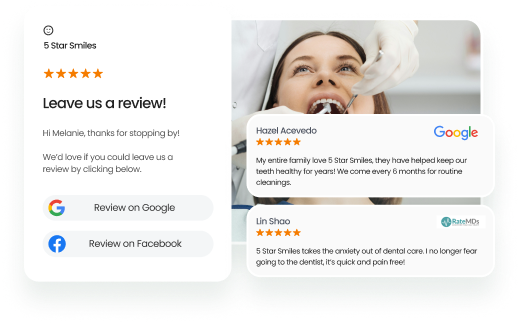Driving social media reviews requires more than just asking customers for feedback. Data shows that a strategic review generation approach can significantly increase revenue, yet most businesses struggle to implement effective systems across multiple locations.
While some brands excel at review generation, others face diminishing engagement despite increased efforts. The difference lies in understanding the psychological triggers that motivate customers to share their experiences and leveraging technology to automate this process intelligently.
In fact, Birdeye’s latest State of Online Reviews 2025 report shows that reviews featuring comments grew from 79% to 81%, highlighting a shift toward more detailed, actionable feedback. For businesses, this trend makes social media reviews even more valuable, offering opportunities to build trust, improve services, and drive long-term loyalty.
In this blog post, we’ll explore proven frameworks for driving genuine social media reviews.
Bottom Line Up Front (BLUF) 💡
Customers don't leave reviews to benefit you—they do it to help others make better decisions. When you align your review generation strategy with this fundamental human motivation, response rates typically increase, helping you drive social media reviews more organically. Modern AI tools can help identify these key moments when customers are most likely to share their experiences.
Table of contents
- The psychology behind why customers write social media reviews
- How to drive social media reviews for improved visibility
- Do social media reviews help with local SEO?
- Importance of responding to reviews on social media
- Ready-to-use response templates to boost social media reviews
- FAQs about how to drive social media reviews
- How Birdeye Social AI helps you drive social media reviews for your business
The psychology behind why customers write social media reviews
To effectively drive social media reviews, businesses must understand the emotional and behavioral triggers behind customer feedback. Most customers don’t write reviews for the brand—they do it to express something personal, emotional, or purposeful.
Why do customers write social media reviews?
- To share strong emotions: Customers are more likely to leave a review after a very positive or negative experience. It’s their way of processing and expressing emotions like happiness, frustration, or relief.
- To help others make decisions: Many people write reviews because they want to guide future buyers. If they’ve had a great experience, they want others to benefit. If not, they want to warn them.
- To feel heard and valued: Writing a review gives customers a voice. It validates their opinions and helps them feel connected to a community.
- To contribute to a larger conversation: Social media reviews aren’t just about the product—they’re about storytelling, influence, and community feedback.
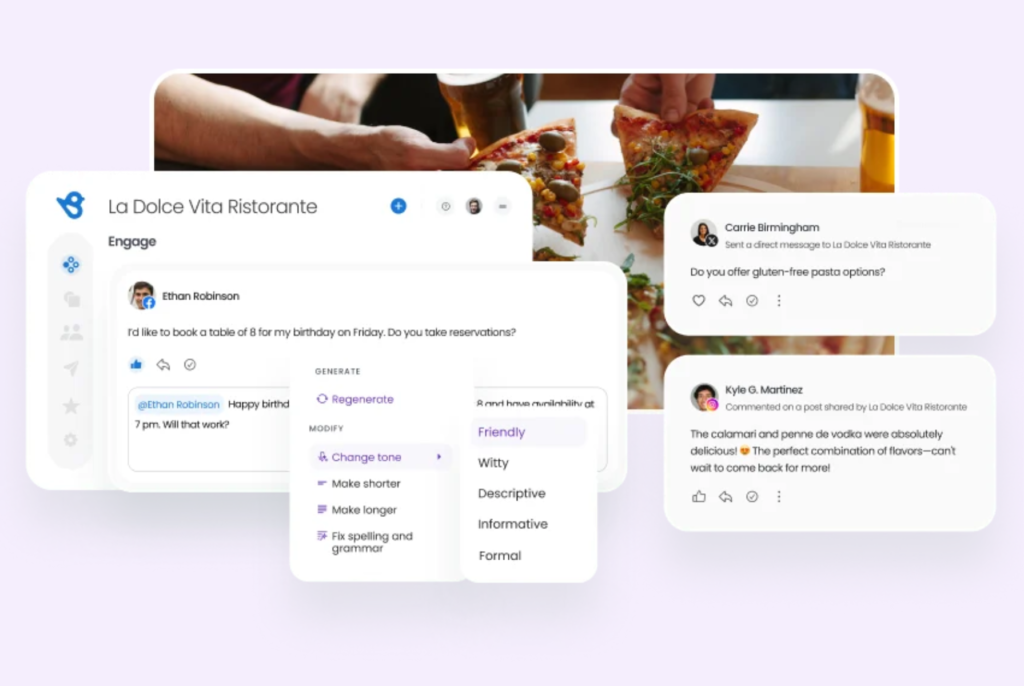
Now, let’s explore some proven strategies to drive social media reviews effectively.
How to drive social media reviews for improved visibility
To drive social media reviews, implement strategies like automating review requests and personalized campaigns. Understand your audience’s motivations and use high-impact tactics for great results
Here are nine proven and results-driven strategies to drive more social media reviews that take some effort but give great results:
1. Deliver exceptional experiences
Trust is the foundation of every great customer relationship, and exceptional service doesn’t just make customers happy—it creates a sense of pride and loyalty that compels them to leave positive reviews.
Here’s how you can foster trust and inspire organic reviews:
- Consistency builds confidence: Ensure every touchpoint—whether a first inquiry, a purchase, or post-sale support—delivers a seamless experience that meets customer expectations. Inconsistencies erode trust, making it less likely for customers to share their experiences.
- Personalized interactions: Customers value feeling seen and appreciated. Gather insights about their preferences, behaviors, and pain points through feedback, surveys, or analytics. Once you know your audience, tailor your approach to meet their specific needs. Personalization might mean recommending products based on past purchases, addressing customers by name, or showing empathy during service interactions.
- Delight your customers: Going above and beyond in small, thoughtful ways can leave a lasting impression. A handwritten thank-you note, an unexpected discount, or a follow-up message of appreciation can turn a satisfied customer into a vocal advocate.
2. Identify the emotional triggers that inspire reviews
Emotions often drive reviews. Customers don’t write reviews simply because they’re asked—they do so because something about their experience stands out and moves them to share it. Identifying and leveraging these emotional triggers allows businesses to encourage authentic and natural feedback.
Here’s how emotions can drive reviews:
- Gratitude and excitement: Positive emotions like joy or appreciation motivate customers to express their happiness. Offering delightful and unexpected moments, such as personalized service, creates these feelings.
- Resolution satisfaction: Resolving a problem with empathy leaves customers feeling valued, often inspiring them to share their relief and gratitude.
- Memorable experiences: Unique moments—like a surprise discount or exceptional service—stay with customers, increasing the likelihood they’ll share their stories.
- Ethical incentives: Everyone loves a little encouragement. A well-times reward can be the perfect nudge to turn happy customers into enthusiastic advocates. Just make sure it feels genuine and follows platform rules.
Pro tip: On certain platforms like Google and Yelp, offering rewards for positive reviews in against the rules. Instead, frame it as a thank-you for their time–regardless of the feedback.
3. Optimize your customer journey for review generation
If you know where to look, the customer journey is a great opportunity to inspire feedback. Reviews often stem from specific touchpoints where customers feel most engaged. Mapping these touchpoints and optimizing them for review requests ensures a natural flow.
Here’s how to make the most of the customer journey:
- Identify key moments, such as after a purchase, service delivery, or issue resolution. These are ideal times to request reviews.
- Streamline post-experience follow-ups and use follow-up emails or messages to guide customers toward leaving feedback. Platforms like Birdeye Social AI can automate this process.
- Remove friction for the customer and ensure review requests are clear, concise, and easy to complete, avoiding unnecessary steps that could discourage participation.
Birdeye Social AI simplifies the process by providing seamless, mobile-friendly social reporting & analytics feature to fine-tune your strategy.
4. Ask for reviews at the right moment
Customers are most receptive when their experience is fresh, and their emotions are high—whether it’s satisfaction, gratitude, or relief. By requesting reviews at the right time, you can significantly improve response rates and the authenticity of the feedback.
Here’s how to identify the perfect moment:
- Right after a positive interaction: Request reviews immediately after a purchase, service completion, or successful resolution of an issue. Customers are most satisfied and motivated to share their experiences in these moments.
- During follow-ups: If a customer leaves positive feedback in a conversation or survey, use that as a springboard to request a review.
- Milestone events: Leverage anniversaries, repeat purchases, or customer loyalty milestones to ask for reviews in a meaningful way.
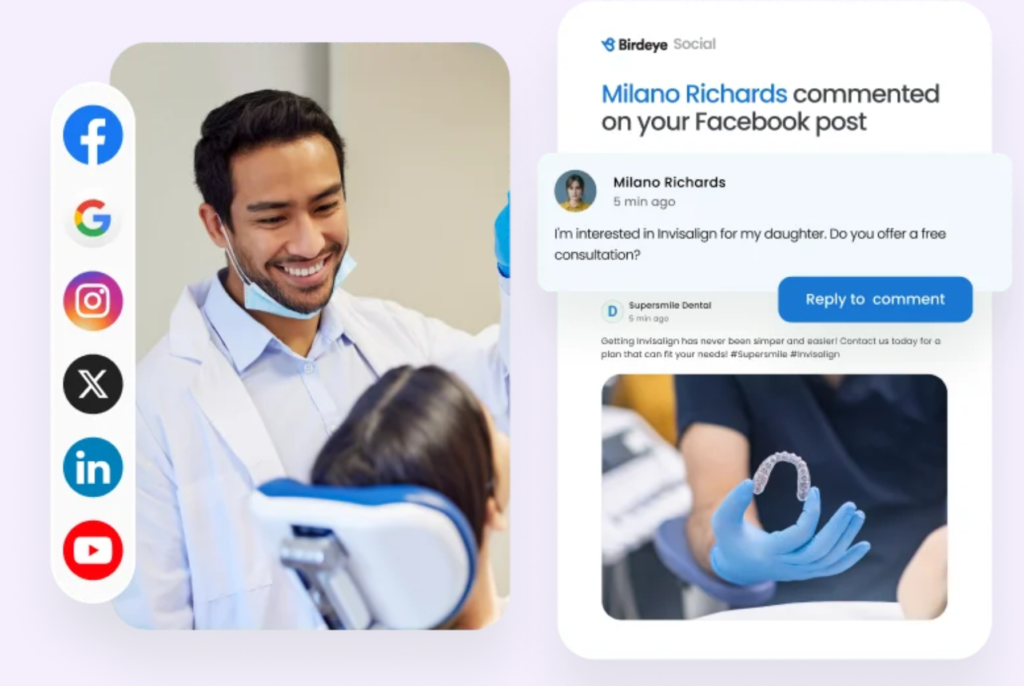
5. Simplify the process to drive social media reviews
Encouraging reviews on social media requires creating a seamless and intuitive process. Social media users expect quick and easy interactions, so you must cater to their behavior to maximize participation.
Here’s how to make it effortless:
- Direct customers to social platforms: Use follow-up messages or QR codes that link directly to your brand’s Facebook, Instagram, or other social pages, making it easy for customers to leave reviews.
- Engage where customers already interact: Ask for reviews through DMs, comments, or replies to your posts, aligning requests with their activity.
- Automate requests via AI tools: With Birdeye Social AI, send personalized, direct review links for platforms like Google Business Profile, Facebook, or Instagram, eliminating barriers and boosting review completion rates.
6. Leverage automation to scale social media review requests
Scaling review requests across social platforms can be time-intensive without the right tools. Automation ensures you consistently reach customers at the right time, making it easier to drive social media reviews effectively.
Here’s how automation helps:
- Personalized requests at scale: Tools like Birdeye Social AI send tailored review requests directly to customers via email, SMS, or social channels, prompting them to leave reviews on platforms like Facebook or Google.
- Platform-specific targeting: Use automation to guide customers toward the platforms most relevant to your business, such as Facebook for visibility or Instagram for visual testimonials.
Automation allows businesses to stay consistent and relevant, increasing the volume of genuine social media reviews without added complexity.
7. Encourage different types of social media reviews
Social media offers diverse review formats, and tapping into these options enhances credibility and reach. Encouraging customers to use a mix of review styles helps showcase your brand dynamically and engagingly.
Here’s how to diversify social media reviews:
- Text-based reviews: Encourage written feedback on platforms like Facebook, which allows for detailed stories that resonate with readers.
- Visual reviews: Platforms like Instagram and TikTok thrive on visual content. Motivate customers to share photos or videos of your product or service and tag your business.
- Star ratings: Ask customers to rate your business directly on platforms like Google and Facebook, where these ratings boost visibility in search results.
With tools like Birdeye Social AI, you can monitor and amplify these reviews, ensuring each format aligns with your social media strategy. Diverse reviews keep your content fresh and appealing to varied audiences.
8. Train your team to request social media reviews effectively
Your team interacts directly with customers, making them the frontline for driving social media reviews. A confident, well-prepared team can turn satisfied customers into vocal advocates by asking for reviews at the right moments.
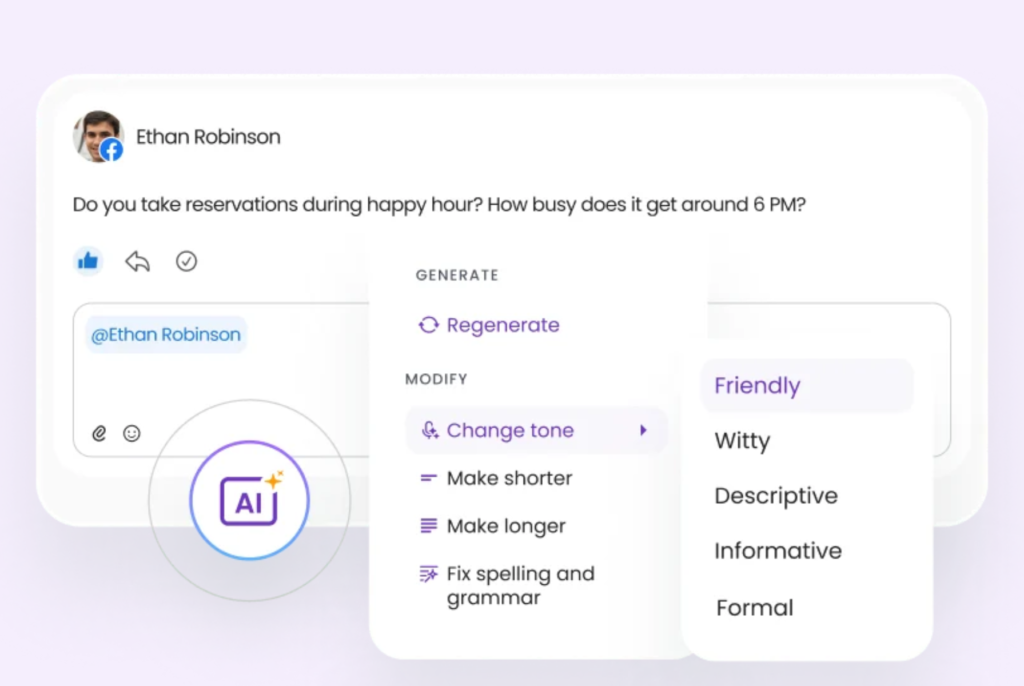
Here’s how to empower your team:
- Provide scripts and training: Equip staff with natural, conversational prompts like, “If you enjoyed your experience, we’d love for you to share it on Facebook or Instagram!”
- Focus on high-impact moments: Encourage requests after exceptional service, resolving an issue, or during follow-ups.
9. Share positive reviews on social media to inspire more feedback
A survey conducted by OnePoll on behalf of Birdeye reveals that Consumers spend an average of 14.1 minutes looking at a service provider’s social media page. This offers a prime opportunity for businesses to showcase positive reviews and inspire others to share their experiences. Here’s how to use positive reviews to drive more:
- Celebrate your customers: Repost or feature glowing reviews across your social channels with visuals, shoutouts, or thank-you messages to show appreciation.
- Use Stories and Reels: Highlight testimonials using Facebook & Instagram Stories, Reels, or TikTok videos. These formats are engaging and easily shareable.
- Encourage engagement: Add a CTA like “Had a similar experience? Let us know in a review!” or “Tag us in your post!”
10. Use AI-driven insights to refine your review strategy
AI can revolutionize how businesses collect, manage, and optimize reviews. With data-driven insights, you can fine-tune your review strategy to drive social media reviews while maximizing impact consistently.
Here’s how Birdeye Social AI can help:
- Monitor performance and strategies to generate positive reviews, allowing you to focus efforts where they yield the highest returns.
- Identify trends in feedback to uncover recurring themes, helping you address concerns and enhance customer experiences.
- Optimize review timing when customers are most likely to leave reviews, ensuring requests are sent at the right moment for maximum engagement.
- Segment audiences effectively based on interactions, tailoring requests for more personalized and relevant outreach.
While AI and automation aid in the growth of your review strategy at scale, it’s equally important that those reviews actually help to get your business found online. That’s where local SEO comes in.
Do social media reviews help with local SEO?
Yes, social media reviews can significantly improve your local SEO rankings. When customers leave positive reviews that include keywords related to your services, products, or location, it helps search engines better understand your business relevance for local search queries.
Here are some best practices for boosting your local SEO through social media reviews:
- Ask customers to mention your business location or service category in their reviews
- Focus review efforts on platforms like Google Business Profile, Facebook, and Yelp that influence local search visibility
- Ensure your business name, address, and phone number (NAP) are consistent across your listings and social profiles
- Reply to reviews consistently, as active engagement can boost trust signals for search engines
When done right, driving social media reviews can both build trust and help your business show up where it matters most: in front of local customers ready to buy.
Importance of responding to reviews on social media
On platforms like Facebook or Instagram, where visibility is high, review responses contribute to your overall brand perception. In fact, Birdeye’s State of Online Reviews reports that in 2024, 73% of customer reviews received a response, up from 63% the year before.
Whether the review is positive or negative, a thoughtful response shows you’re engaged, attentive, and committed to improving the customer experience.
Public replies humanize your brand and can turn a one-time reviewer into a loyal advocate. When potential customers see that you take time to acknowledge reviews, it builds credibility and encourages them to choose your business over competitors who remain silent.
Thus, consistent engagement through review replies not only strengthens customer relationships but also increases the chances of more people leaving feedback, knowing it will be seen and appreciated.
Now, let’s look at some ready-made templates tailored to different review types to streamline your responses and stay consistent.
Ready-to-use response templates to boost social media reviews
Crafting thoughtful, standardized responses to social media reviews is essential for maintaining a consistent and professional online presence. Whether a review is positive, negative, neutral, or mixed, having templates ready ensures your responses are timely, on-brand, and impactful. These templates can help you engage with customers effectively and encourage more reviews.
Here are tailored templates for different review scenarios:
✅ Positive reviews: Acknowledge their feedback and highlight your commitment to quality. Here’s a practical response template. Customize and tweak as per your requirements:
Hi [Customer’s Name],
Thank you for your kind words! 🌟 We’re delighted you enjoyed [specific service/product]. Let us know how we can serve you again!
✅ Negative reviews: Apologize for their experience, promise improvement, and provide a resolution path. Here’s a practical response template. Customize and tweak as per your requirements:
Hi [Customer’s Name],
We’re sorry to hear this. Please get in touch with us at [email/phone] so we can address your concerns and make things right.
Neutral reviews: Thank them for their input and invite them to share further details. Here’s a practical response template. Customize and tweak as per your requirements:
Hi [Customer’s Name],
Thanks for your feedback! We’d love to hear how we can improve. Reach out at [email/phone] with any suggestions.
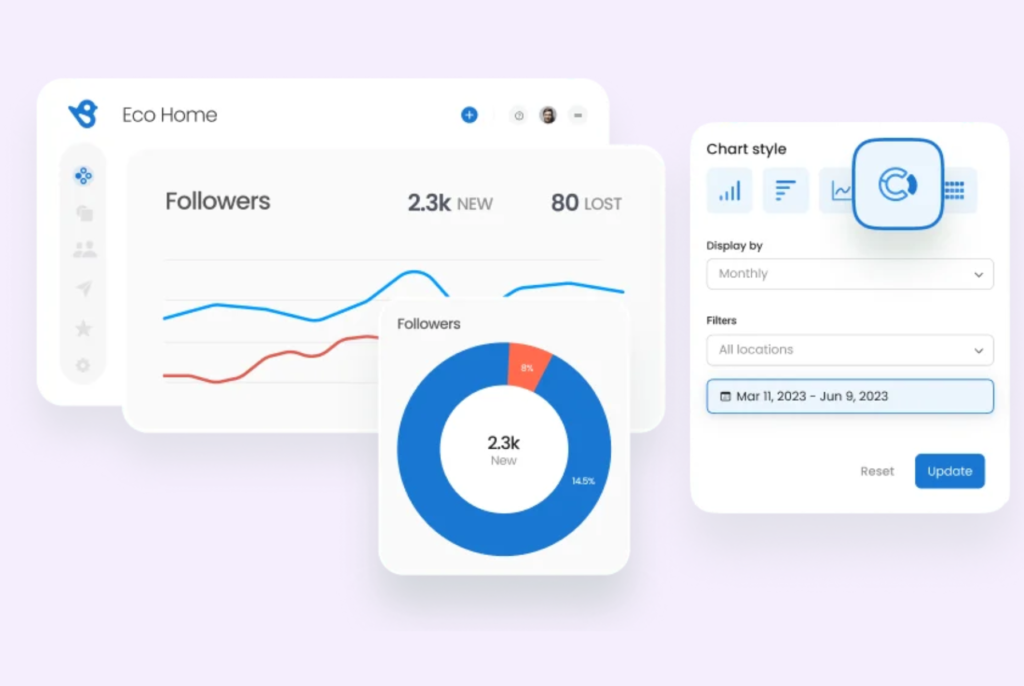
Manage Social Media Stress-free
Want to see the impact of Birdeye on your business? Watch the Free Demo Now.
FAQs about how to drive social media reviews
Trustworthy reviews are authentic, specific, and reflect real customer experiences. To drive social media reviews that inspire confidence, companies should focus on delivering exceptional service and encouraging detailed feedback. Responding to reviews promptly builds trust and strengthens your branding, demonstrating that you value customer input.
Social media reviews, especially on platforms like Google and Facebook, boost local SEO by increasing trust signals, improving relevance for local search terms, and driving engagement. Consistent, positive reviews can help your business appear in Google’s local 3-pack and map results.
It’s best to ask for reviews shortly after a positive interaction with your customers, when the experience is fresh and emotions are high. Avoid overwhelming customers—well-timed, thoughtfully spaced requests lead to better response rates.
Offer small tokens of appreciation like discounts, loyalty points, or entry into a giveaway—without asking for a positive review. Always follow platform guidelines and make it clear that honest feedback is welcome, whether it’s good or bad.
Respond quickly and calmly. Acknowledge the issue, apologize if needed, and offer a way to resolve it offline. Avoid defensive language. A thoughtful response shows professionalism and can rebuild trust with both the reviewer and future customers.
To maintain high-quality reviews, simplify the customer review process, and focus on natural, unsolicited feedback. Use knowledge gained from customer interactions to create personalized review requests. Additionally, monitoring and removing fake or spam reviews ensures the integrity of your review system, helping you drive social media reviews effectively.
Thank the customer, personalize your response, and address their feedback directly. Keep it professional and friendly. For negative reviews, show empathy and offer solutions. Consistent responses build credibility and encourage more engagement.
Focus on platforms your audience actively uses, like Google, Facebook, and Birdeye. For specific industries, LinkedIn or Instagram may also influence customer decisions. Regularly review performance metrics to see where you get the most clicks and engagements. These insights help refine your efforts to drive social media reviews and enhance branding.
How Birdeye Social AI helps you drive social media reviews for your business
To drive social media reviews successfully, businesses need a strategic approach combining personalized outreach, proactive engagement, and intelligent tools. Reviews are not just feedback—they’re a powerful driver of trust, visibility, and branding that can fuel long-term growth.
With Birdeye Social AI, you can effectively streamline your efforts to collect, manage, and leverage reviews. It is perfect for companies with multiple locations, allowing tailored review generation and management for each region to maximize local impact with:
- Effortless content creation in minutes using AI’s recommendations tailored to your industry.
- Automated scheduling to save time by bulk-publishing posts across platforms and locations with personalized customization.
- Leverage AI to publish content when it’s most likely to perform well.
- Analyze post-performance, track audience growth, and refine your strategy using data-driven insights.
“Birdeye- your one and only social media monitor. We are able to see all the reviews in one place without having to log in to each social media account. Seeing all reviews in one place helps you determine where you need to work on your products/business. Overall, I like how Birdeye allows you to see and manage all your online/social media reviews and control your online reputation.”
— Ganesh Joshi (Register Tape Network)
Watch our free demo to learn more about how Birdeye can transform your business’s marketing operations.

Originally published









